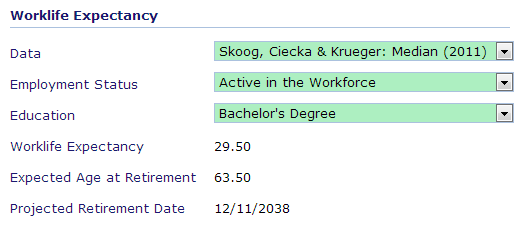The Worklife Expectancy options determine how the plaintiff's expected worklife is calculated.
Worklife Expectancy Options

Determines which academic study is used to calculate the worklife expectancy. Also determines which settings are available in the next two options. For example, when you select the Median Years to Retirement study, the Employment Status option is disabled. This is because that study does not contain data for employed individuals versus unemployed individuals or versus the entire workforce. For the data citation of a specific study, see Worklife Expectancy Data.
Sets the employment status of the plaintiff. Available options are determined by the Data setting. Disabled when the Median Years to Retirement study is selected.
Sets the level of education attained by the plaintiff. Available options are determined by the Data setting.
Two of the seven worklife studies contain data for race:
Contain Race Data |
Do Not Contain Race Data |
|---|---|
Bureau of Labor Statistics (1986) |
Hunt, Pickersgill & Rutemiller (2001) |
Ciecka, Donley & Goldman (2000) |
Krueger, Skoog & Ciecka (2007) |
|
Median Years to Retirement (2001) |
|
Skoog & Ciecka (2003) |
|
Skoog, Ciecka & Krueger (2011) |
Note: |
Race data is available for all of the Employment Status settings, but is not available for a specific education level. To apply race data, you must select Not Applied for the Education option. |